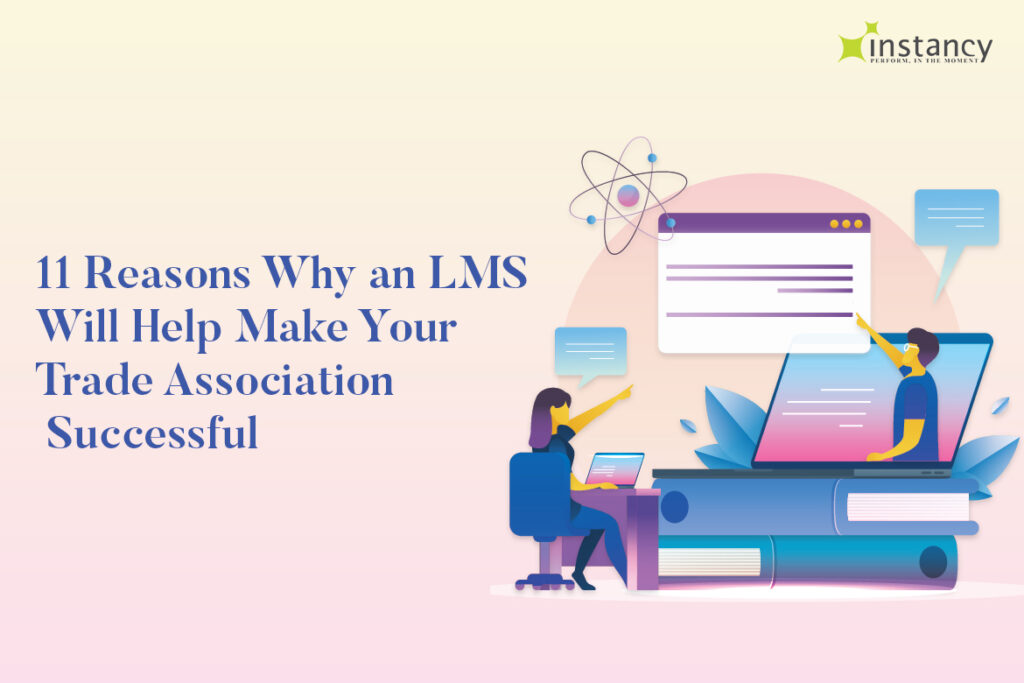Introduction
Trade associations are organizations that represent the interests of their members, typically in a specific industry. Trade associations serve many functions, but the most important is to educate and create awareness among members about regulatory changes and developments. Also, today’s newest technology may become redundant after a few months in this fast-paced world where practically everything changes at breakneck speed.
For trade associations, education cannot be left to chance; they need to be constantly educating their members. Members might not have time to stay up to date on new regulations or get the necessary training for their jobs.
So what can trade associations do? Trade associations can turn to Instancy learning platform, an all-in-one platform to create, deliver, manage blended learning programs including webinars, podcasts, and eLearning courses, certifications, credits and more. Instancy Learning Management System and mobile learning apps provide a convenient way for trade association member benefits without having to take any extra time out of their day to keep up!
You may wonder why you need to adopt a Learning Management System for your association and your members.
One can never be fully aware of all the training resources that different departments have if you don’t have a centralized and organized place to host your learning resources – like an LMS.
That means there’s a good chance training programs or courses in your association’s learning portal will be reproduced. Consider how much time and effort it will take to manage them manually. This mismanagement will result in a lack of ownership, the absence of processes and standards, and the presence of obsolete courses on the portal.
With the use of a Learning Management System, these challenges can be readily resolved.
Associations need a modern learning infrastructure to aggregate, curate, organize knowledge and educational resources. They also need to empower their members to contribute to this dynamic knowledge.
They need to make this knowledge engaging and deliver it in ways that is best suited for the learning needs and preferences of their audience
Modern and innovative learning management systems and tools can help tremendously achieve this objective. Let us further delve into this concept and understand the basics of an LMS and its features for associations.
What is an LMS?
According to Fortune Business Insights, the global LMS market was valued at $8.76 billion in 2019 and is expected to grow to $38.10 billion by 2027 with a Compound Annual Growth Rate (CAGR) of 19.7% during the forecast period.
In the context of associations, learning management platforms encourage members to advance their skills and knowledge by providing them with valuable certificates that can help them advance their professions and access new prospects. They specifically include several features tailored to the needs of membership groups.
Why Do You Require an LMS for Your Association?
Any association’s primary goal is to bring together individuals or groups with similar interests, purposes, or professions from various industries. Associations require a top learning management system (LMS) for members, partners, and other stakeholders to stay up with the evolving ecosystem, regulations, standards and build skills for career progression, among other things. The main reasons to have a robust LMS for your association are as follows :
1.Increases Non-Dues Revenue
A well-designed LMS can ensure that associations can sell their training courses and material to members and non-members simultaneously for non-dues revenue generation. Members can easily acquire courses and other association items with discounts and vouchers to begin learning. Administrators can configure and set up products (LMS deliverables) and automate LMS integration processes, eliminating data silos. Using e-commerce connectivity, course and certification exam costs can be added to the non-dues revenue. Non-members can be charged a price to access specific learning resources, generating an additional non-dues revenue stream.
Using the right LMS platform can help in continuous data monitoring and calculate your growth trajectory and make data-driven decisions to boost member engagement and build a better member community when you can monitor and analyze your metrics in the most optimum manner.

2.Centralized Repository
It’s time for an LMS if you’re managing your learning content using a combination of spreadsheets, Google docs, questionnaires, videos, and calendars. If you’ve ever utilized a system like this to organize your learning resources over a long period, you understand how time-consuming it can be. You’re probably in need of a centralized storage system for your digital instructional resources. A good LMS also allows you to reuse your materially optimally over some time.
3.Flexibility in Learning
Selling your online courses or certification materials through a learning management system could help you generate non-dues revenue. Prices for courses can be set individually or based on membership tiers. Members in your highest level may have free access to all your courses, while those in lesser tiers may have to pay for more in-depth content.
The finest LMS software supports a wide range of material types, making it simple to construct online courses that include text, videos, live webinars, and assessments to determine how much knowledge members retain.

4.Enhances Membership Experience
An LMS can be set up to deliver relevant, engaging content on several topics related to a profession’s numerous diverse tasks.
Covering such a wide range of topics in a traditional training environment might be difficult with limited time and space. An LMS, on the other hand, can readily handle a wide range of topics, courses, and learning routes, giving members the freedom to choose what’s most important to their professions.
You can produce compelling training content for your members’ online and offline learning by selecting the correct LMS for your association. The quest for an association LMS was prompted by the need to educate members and provide them with on-demand, role-specific training.
These LMS are in high demand because they eliminate manual exports related to member data and reduces customization costs
LMS encourages professional growth and member loyalty, leading to significant rewards such as higher revenue and job prospects in the future. Hence, it helps to foster holistic development for the entire organization.
5.Certificates, Credit Tracking and Digital Badges
Members opt to enroll in a trade association to grow and improve their existing skills and knowledge. to track credits and certificates as they advance their professions and complete yearly accreditation criteria, so associations should keep that in mind.
Tracking is especially critical for associations in industries like:
The medical profession (nurses, doctors, therapists, etc.)
Education (professors, teachers, teaching aids, etc.)
Any enterprise classified as a trade (electricians, plumbers, etc.)
A trade association should choose an LMS that can give accreditation and certification in whatever format the members’ industry requires. Members should display digital badges or certificates on their social accounts and websites to showcase their achievements to the rest of the world. These certificates and badges will help them grow professionally and ensure the participation of new members.
6.Integration with your existing AMS
It is necessary to think about -How will the LMS fit into your current technological approach and integrate with the rest of your system?
Your association can use the LMS-AMS integration to seamlessly integrate learner data, generate training reports, and enroll stakeholders for onboarding and compliance training. As a result, more significant association LMS training is available, with actionable information to help fulfill sales targets while providing a better member experience. The AMS integration increases open communication, identifies learner pain points, and tracks and evaluates online and offline course sales.
The best practice in the case of LMS, for example, is to link it with your existing system so flawlessly that your members only need to log into your website to have access.
The integration makes it easier for your members to enroll in courses, and it also makes it easier for your member support team to answer more minor customer service queries.
7.Aids Social and Collaborative Learning
61% of associations say that networking with others in their industry is the most important motivation for members to join (Marketing General, Inc.).
Association members can participate in a mentor-mentee program to communicate with experts and share their thoughts, questions, and hypotheses which will help them to learn more effectively.
Discussion forums, real-time chat with experts, and various evaluations also help create a collaborative learning experience.

8.Built-In Authoring
Naturally, the members will want to take up the courses only if they find it helpful and appealing. When selecting an association LMS, make sure it allows your team to create and build courses from within the platform.
This way, you will be assured that your data is safe and presented appealingly and understandably.
What should your team be able to include with course authoring?
- Videos and photographs provide visual interest.
- Additional learning tactics can be achieved through games.
- For diversity, use interactive drag-and-drop experiences.
You’ll see increased attendance in your courses if your LMS assists your team in creating the most functional course feasible while also keeping user experience in mind.
9.Provides Micro and Macro Learning
Since everyone’s leading hectic lives, it’s tough to develop a practice of attending classes or taking up online modules regularly. Associations can allow people to test out online learning in bite-sized chunks, referred to as microlearning, and progressively prepare them to commit to a more significant commitment.
Many members choose bite-sized learning in the form of short videos or web stories since they are time-efficient, engaging, and valuable. They can’t take a standard course since they’re too busy. You may get them started with a few samples of bite-sized learning and short modules by integrating an LMS and keeping track of a learner’s progress. They can gradually follow the path of a learning pathway comprised of short modules. As members advance along the route, their desire to learn more will grow along with their sense of achievement.
10.Enables Remote Learning
A web- or cloud-based LMS allows members to access data at any time and from any location. Rather than attending training at a pre-determined, defined period that may clash with other duties, members can take required courses at their convenience.
Members can also access a choice of training courses from any location, on any computer or mobile device, with the correct LMS.
Mobile-based learning gives the members the flexibility to access content from any location. Offering a platform outside of the classroom and utilizing a blended learning experience, on the other hand, can allow participants to learn on their own time. They can also be given reminders and held accountable for their learning outcomes in various ways.
11.Keeping up with the Latest Trends
A great LMS can help your members to provide frequent updates and news regarding their industries. The current events directly impact every profession in a significant way. Updated articles, web stories, and videos presented through the LMS platform can help the members to be in pace with the changes happening around them in terms of the latest technology or evolving practices.
Through discussion forums and the presentation of various ideas, associations can also encourage varied members to present their experiences and thoughts they have acquired over a period of time.

A Robust LMS Solution for Associations
Instancy provides a robust cloud-based learning platform and system integration services so that association training team can create, deliver, and manage all the blended learning programs to grow and retain your association members.
A modern learning experience platform (LXP) ensures that association members can access content on websites, mobile apps, or business collaboration tools such as Microsoft Teams. Social learning and networking is embedded within the Instancy LXP. An integrated content management system enables association members and experts to contribute content ranging from microlearning, videos, virtual classes, assessments, learning paths, and more.
Instancy LMS suite also helps trade associations deploy a branded learning ecosystem to help you scale up the training to remain ahead of the curve.
Conclusion
In order to grow and retain members, associations must adopt the best tools and infrastructure that improves knowledge aggregation and dissemination at speed and scale. A modern LMS can go a long way in enhancing the knowledge workflow, content reuse, blended learning, data tracking, and reporting, automating administrative learning tasks such as notifications. In the days ahead, new technologies such as Web 3.0 and artificial intelligence are expected to advance learning personalization further, data privacy, enhance user experience. Stay tuned.





